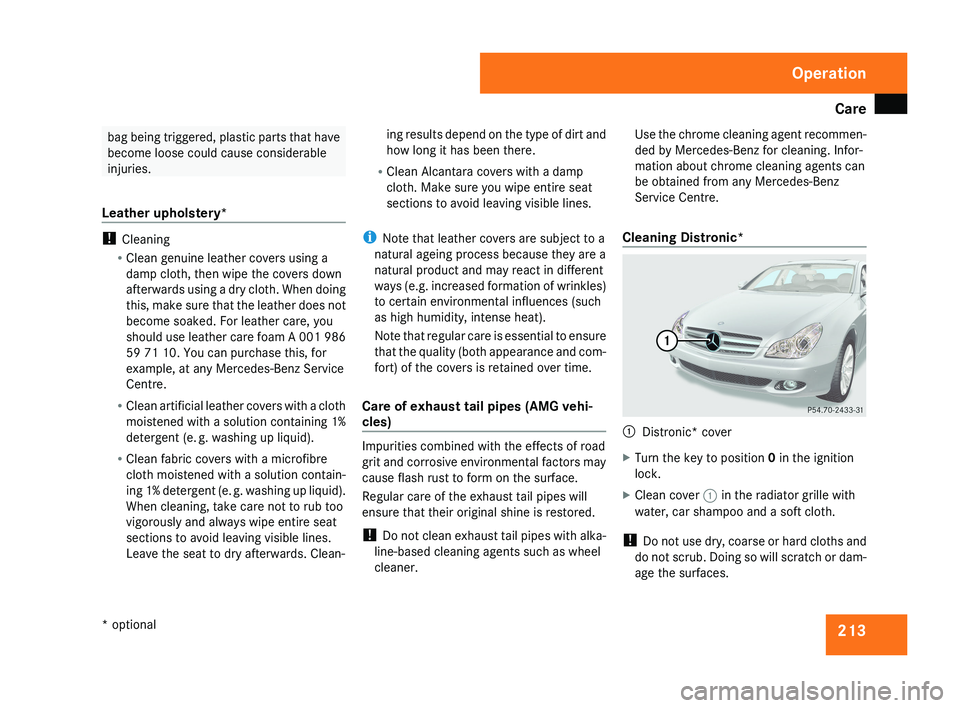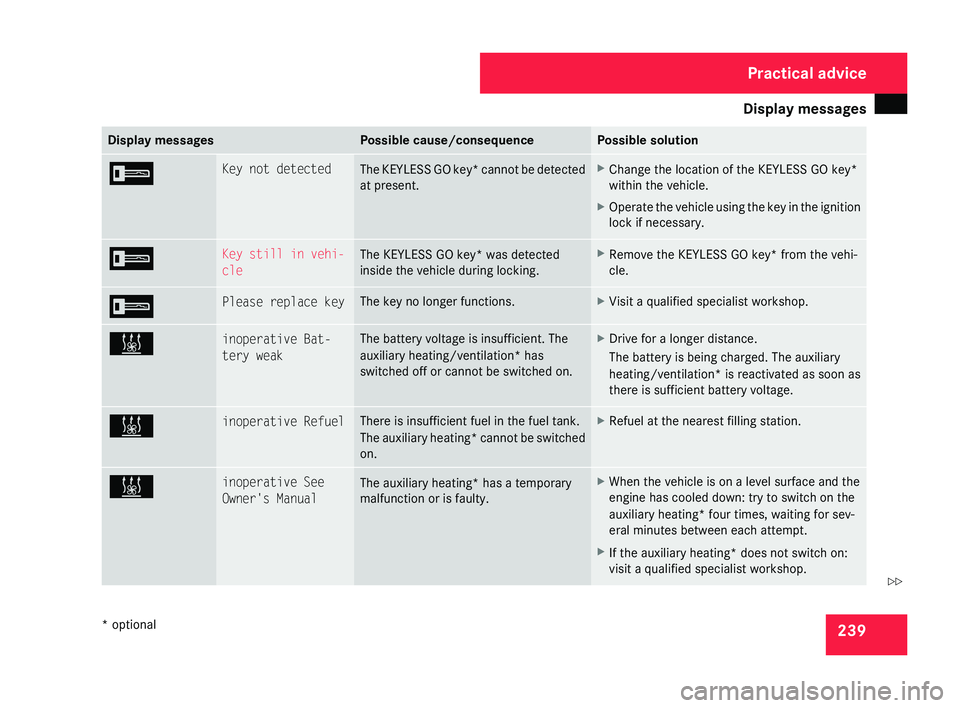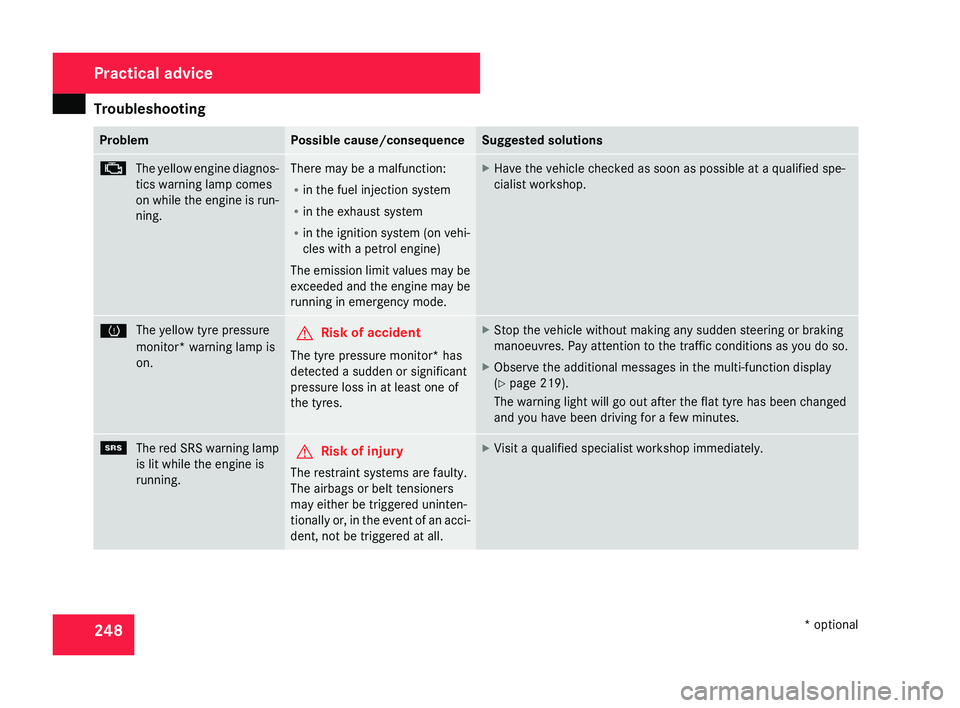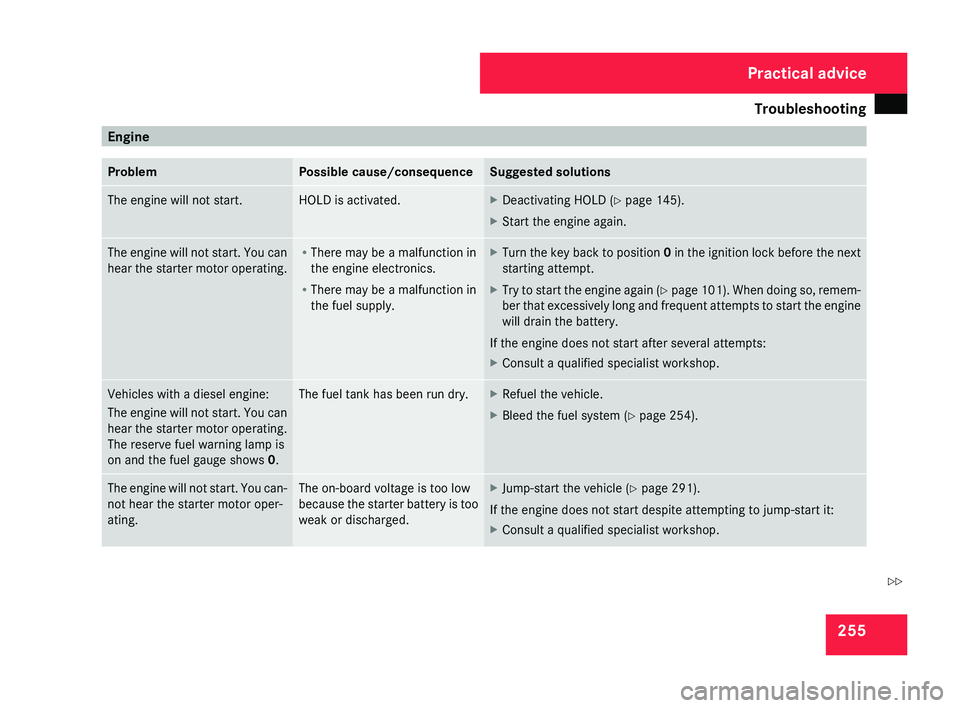Page 216 of 329

Care
213bag being triggered, plastic parts that have
become loose could cause considerable
injuries.
Leather upholstery* !
Cleaning
R Clean genuine leather covers using a
damp cloth, then wipe the covers down
afterwards using a dry cloth. When doing
this, make sure that the leather does not
become soaked. For leather care, you
should use leather care foam A 001 986
59 71 10. You can purchase this, for
example, at any Mercedes-Benz Service
Centre.
R Clean artificial leather covers with a cloth
moistened with a solution containing 1%
detergent (e. g. washing up liquid).
R Clean fabric covers with a microfibre
cloth moistened with a solution contain-
ing 1% detergent (e. g. washing up liquid).
When cleaning, take care not to rub too
vigorously and always wipe entire seat
sections to avoid leaving visible lines.
Leave the seat to dry afterwards. Clean- ing results depend on the type of dirt and
how long it has been there.
R Clean Alcantara covers with a damp
cloth. Make sure you wipe entire seat
sections to avoid leaving visible lines.
i Note that leather covers are subject to a
natural ageing process because they are a
natural product and may react in different
ways (e.g. increased formation of wrinkles)
to certain environmental influences (such
as high humidity, intense heat).
Note that regular care is essential to ensure
that the quality (both appearance and com-
fort) of the covers is retained over time.
Care of exhaust tail pipes (AMG vehi-
cles) Impurities combined with the effects of road
grit and corrosive environmental factors may
cause flash rust to form on the surface.
Regular care of the exhaust tail pipes will
ensure that their original shine is restored.
!
Do not clean exhaust tail pipes with alka-
line-based cleaning agents such as wheel
cleaner. Use the chrome cleaning agent recommen-
ded by Mercedes-Benz for cleaning. Infor-
mation about chrome cleaning agents can
be obtained from any Mercedes-Benz
Service Centre.
Cleaning Distronic* 1
Distronic* cover
X Turn the key to position 0 in the ignition
lock.
X Clean cover 1 in the radiator grille with
water, car shampoo and a soft cloth.
! Do not use dry, coarse or hard cloths and
do not scrub. Doing so will scratch or dam-
age the surfaces. Operation
* optional
219_AKB; 2; 4, en-GB
mkalafa,
2007-11-13T09:28:36+01:00 - Seite 213
Page 241 of 329

Display messages
238 Display messages Possible cause/consequence Possible solution
H Tyre pressure
Check tyres The pressure in one or more tyres has
dropped significantly. The affected wheel
is highlighted in the tyre pressure display
of the tyre pressure monitor*. X
Stop the vehicle without making any sudden
steering
or braking manoeuvres. Pay attention
to the traffic conditions as you do so.
X Check the tyres.
X Repair or change the faulty tyre if necessary
(Y page 276).
X Check the tyre pressure and correct it if nec-
essary ( Y page 200).
The warning will disappear automatically after
you have been driving for a few minutes with
the corrected tyre pressure. I Change key batter-
ies
The batteries of the KEYLESS GO key* are
discharged. X
Change the batteries ( Y page 269).I Key not detected
The KEYLESS GO key* is not in the vehicle.
It will no longer be possible to centrally
lock
the vehicle and start the engine if the
engine is switched off. X
Stop the vehicle. Pay attention to the traffic
conditions as you do so.
X Look for the KEYLESS GO key*. I Key not detected
The KEYLESS GO * key is not detected
while
the engine is running, because there
is interference from a strong source of
radio waves. X
Stop the vehicle. Pay attention to the traffic
conditions as you do so.
X Operate the vehicle using the key in the ignition
lock if necessary. Practical advice
* optional
219_AKB; 2; 4, en-GB
mkalafa,
2007-11-13T09:28:36+01:00 - Seite 238
Page 242 of 329

Display messages
239Display messages Possible cause/consequence Possible solution
I Key not detected
The KEYLESS GO key* cannot be detected
at present. X
Change the location of the KEYLESS GO key*
within the vehicle.
X Operate the vehicle using the key in the ignition
lock if necessary. I Key still in vehi-
cle
The KEYLESS GO key* was detected
inside the vehicle during locking. X
Remove the KEYLESS GO key* from the vehi-
cle. I Please replace key The key no longer functions. X
Visit a qualified specialist workshop. X inoperative Bat-
tery weak The battery voltage is insufficient. The
auxiliary heating/ventilation*
has
switched off or cannot be switched on. X
Drive for a longer distance.
The battery is being charged. The auxiliary
heating/ventilation* is reactivated as soon as
there is sufficient battery voltage. X inoperative Refuel There is insufficient fuel in the fuel tank.
The
auxiliary heating* cannot be switched
on. X
Refuel at the nearest filling station. X inoperative See
Owner's Manual
The auxiliary heating* has a temporary
malfunction or is faulty. X
When the vehicle is on a level surface and the
engine has cooled down: try to switch on the
auxiliary heating*
four times, waiting for sev-
eral minutes between each attempt.
X If the auxiliary heating* does not switch on:
visit a qualified specialist workshop. Practical advice
* optional
219_AKB; 2; 4, en-GB
mkalafa,
2007-11-13T09:28:36+01:00 - Seite 239 Z
Page 251 of 329

Troubleshooting
248 Problem Possible cause/consequence Suggested solutions
±
The yellow engine diagnos-
tics warning lamp comes
on
while the engine is run-
ning. There may be a malfunction:
R
in the fuel injection system
R in the exhaust system
R in
the ignition system (on vehi-
cles with a petrol engine)
The emission limit values may be
exceeded and the engine may be
running in emergency mode. X
Have the vehicle checked as soon as possible at a qualified spe-
cialist workshop. H
The yellow tyre pressure
monitor* warning lamp is
on. G
Risk of accident
The tyre pressure monitor* has
detected a sudden or significant
pressure loss in at least one of
the tyres. X
Stop the vehicle without making any sudden steering or braking
manoeuvres. Pay attention to the traffic conditions as you do so.
X Observe the additional messages in the multi-function display
(Y page 219).
The warning light will go out after the flat tyre has been changed
and you have been driving for a few minutes. 1
The red SRS warning lamp
is lit while the engine is
running. G
Risk of injury
The restraint systems are faulty.
The airbags or belt tensioners
may either be triggered uninten-
tionally
or, in the event of an acci-
dent, not be triggered at all. X
Visit a qualified specialist workshop immediately. Practical advice
* optional
219_AKB; 2; 4, en-GB
mkalafa,
2007-11-13T09:28:36+01:00 - Seite 248
Page 255 of 329
Troubleshooting
252 Accident
Problem Possible cause/consequence Suggested solutions
Fuel is leaking from the vehicle.
G
Risk of fire
The fuel line or the fuel tank has
been damaged. X
Switch off the ignition immediately.
X Remove the ignition key.
X Do not restart the engine under any circumstances.
The leaking fuel creates a risk of fire or explosion.
X Consult a qualified specialist workshop. You are unable to determine the
extent of the damage. X
Consult a qualified specialist workshop. You cannot detect any damage. X
Start the engine as normal. The NECK-PRO head restraints
on the driver's and front-
passenger seats have been trig-
gered. Your vehicle has been involved in
a rear-end collision. X
Reset the NECK-PRO head restraints (Y page 269). Practical advice
219_AKB; 2; 4, en-GB
mkalafa,
2007-11-13T09:28:36+01:00 - Seite 252
Page 256 of 329
Troubleshooting
253Fuel and fuel tank
Problem Possible cause/consequence Suggested solutions
Fuel is leaking from the vehicle.
G
Risk of fire
The fuel line or the fuel tank is
defective. X
Turn the key to position 0 in the ignition lock immediately and
remove it.
X Do not restart the engine under any circumstances.
The leaking fuel creates a risk of fire or explosion.
X Consult a qualified specialist workshop. The fuel filler flap cannot be
opened. The fuel filler flap is not released. X
Unlock the vehicle (Y page 266). The opening mechanism is jam-
med. X
Consult a qualified specialist workshop. Practical advice
219_AKB; 2; 4, en-GB
mkalafa,
2007-11-13T09:28:36+01:00 - Seite 253 Z
Page 257 of 329
Troubleshooting
254 Problem Possible cause/consequence Suggested solutions
The fuel tank has been run com-
pletely dry on a vehicle with a
diesel engine. There is air in the fuel system. X
Refuel the vehicle.
X Switch on the ignition for approximately 10 seconds (key in posi-
tion 2 in the ignition lock).
X Start the engine continuously for up to 40 seconds until it runs
smoothly.
The fuel system is now free of air.
If the engine does not start:
X Wait two minutes.
X Repeat the starting procedure for up to 40 seconds.
If the engine still does not start:
X Consult a qualified specialist workshop. Practical advice
219_AKB; 2; 4, en-GB
mkalafa,
2007-11-13T09:28:36+01:00 - Seite 254
Page 258 of 329

Troubleshooting
255Engine
Problem Possible cause/consequence Suggested solutions
The engine will not start. HOLD is activated. X
Deactivating HOLD (Y page 145).
X Start the engine again. The engine will not start. You can
hear
the starter motor operating. R
There may be a malfunction in
the engine electronics.
R There may be a malfunction in
the fuel supply. X
Turn the key back to position 0 in the ignition lock before the next
starting attempt.
X Try to start the engine again (Y
page 101). When doing so, remem-
ber that excessively long and frequent attempts to start the engine
will drain the battery.
If the engine does not start after several attempts:
X Consult a qualified specialist workshop. Vehicles with a diesel engine:
The
engine will not start. You can
hear the starter motor operating.
The reserve fuel warning lamp is
on and the fuel gauge shows 0. The fuel tank has been run dry. X
Refuel the vehicle.
X Bleed the fuel system (Y page 254). The engine will not start. You can-
not hear the starter motor oper-
ating. The on-board voltage is too low
because
the starter battery is too
weak or discharged. X
Jump-start the vehicle (Y page 291).
If the engine does not start despite attempting to jump-start it:
X Consult a qualified specialist workshop. Practical advice
219_AKB; 2; 4, en-GB
mkalafa,
2007-11-13T09:28:36+01:00 - Seite 255 Z